Poison Oak
(click here to learn about Stinging Nettles)
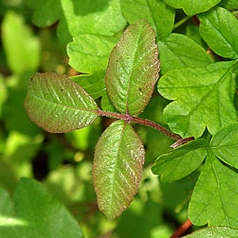 Poison Oak Poison Oak 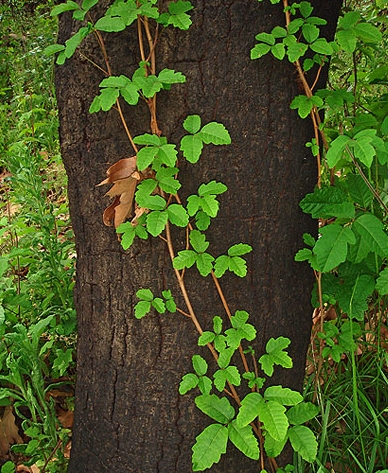 is found throughout California, at elevations below 4,000 feet, as both a free-standing shrub, 12" to 30" high, and as a vine trailing around tree trunks. It is most abundant in shaded oak and scrub forests where a creek is nearby. The plant is easily identified by leaves arranged in groups of three, which gives rise to the phrase "leaves of three, let me be". These leaves in spring and summer are a brilliant dark green with lobate, toothed edges, which makes them resemble oak tree leaves . . . hence the name. But most of the leaves yellow in autumn and may even turn brilliant red, just before the plant loses its leaves for winter. Poison Oak also has white, fuzzy berries in the spring, which become dun-colored later in the season. These berries, which many animals eat with no ill effects, give rise to the phrase "berries white, poisonous site". is found throughout California, at elevations below 4,000 feet, as both a free-standing shrub, 12" to 30" high, and as a vine trailing around tree trunks. It is most abundant in shaded oak and scrub forests where a creek is nearby. The plant is easily identified by leaves arranged in groups of three, which gives rise to the phrase "leaves of three, let me be". These leaves in spring and summer are a brilliant dark green with lobate, toothed edges, which makes them resemble oak tree leaves . . . hence the name. But most of the leaves yellow in autumn and may even turn brilliant red, just before the plant loses its leaves for winter. Poison Oak also has white, fuzzy berries in the spring, which become dun-colored later in the season. These berries, which many animals eat with no ill effects, give rise to the phrase "berries white, poisonous site".
Western Poison Oak is found throughout California, while Eastern Poison Oak is found in the southern and eastern United States. A variety of Poison Oak is also found in Japan, where it is most abundant in old-growth forests. Poison Ivy is very similar to poison oak, with white berries and leaves of three which can be either toothed or smooth, but it is not found in California. Poison Ivy leaves are pointed, whereas poison oak has lobate leaves shaped like those from oak trees. Poison Sumac, the third member of the family, grows in swamps in the Eastern United States, so we don't need to worry aobut it in California. It has conspicuous red stems, with normal looking leaves, and it causes the same red, itchy rash as the other two.

Distribution of Poison Oak and Ivy
(Rhodara Botanical Journal, 1971, vol. 73)

 Western and Eastern Poison Oak Western and Eastern Poison Oak
 Central, Southern, Eastern, and Rydberg's Posion Ivy Central, Southern, Eastern, and Rydberg's Posion Ivy
First Aid
 Touching or rubbing against bruised or broken Poison Oak leaves, or even against the dormant stems in winter, releases an oily resin called "toxicodendrol", which contains the poisonous chemical "urushiol". If you get this oil on your skin, an allergic reaction may result. The severity of this reaction depends on the person, and some people are virtually immune to Poison Oak. However for most, a red, itchy rash appears 30 minutes to 2 weeks after exposure, and lasts for 1 to 2 weeks. This rash is often puffy with watery blisters, and the more you scratch it, the more it spreads. Severe cases can lead to scabs and bacterial infections. The primary first aid is to keep the rash from spreading and getting worse! Touching or rubbing against bruised or broken Poison Oak leaves, or even against the dormant stems in winter, releases an oily resin called "toxicodendrol", which contains the poisonous chemical "urushiol". If you get this oil on your skin, an allergic reaction may result. The severity of this reaction depends on the person, and some people are virtually immune to Poison Oak. However for most, a red, itchy rash appears 30 minutes to 2 weeks after exposure, and lasts for 1 to 2 weeks. This rash is often puffy with watery blisters, and the more you scratch it, the more it spreads. Severe cases can lead to scabs and bacterial infections. The primary first aid is to keep the rash from spreading and getting worse!
- Wash with soap and cold water to remove any oil left on the skin. Warm water only opens your pores, allowing the Poison Oak oil to enter and increase the area of exposure. Supposedly, washing with manzanita tea removes the oil as well.
- Don't scratch it. Although scratching is hard to resist, it only spreads the oil, thereby affecting more areas.
- Relieve the itching. Although calomine lotion is the age-old remedy for this, some claim that washing with manzanita tea works better and washes off the oil as well.
If a Poison Oak rash persists for more than a couple of weeks, spreads to sensitive areas, or begins to scab over . . . see a doctor immediately!.
Prevention
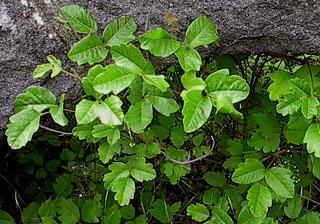 The best first aid for Poison Oak is to avoid catching it in the first place! The best first aid for Poison Oak is to avoid catching it in the first place!
- Don't rub against the leaves or stems.
- Remember to wash your hands and arms thoroughly any time you have been near Poison Oak, particularly before going to the bathroom.
- Do not handle the clothes of people who have been walking through, or working in, Poison Oak. Many Moms have gotten Poison Oak from simply putting in the washing machine the clothes of family members who were out in the stuff and then left their clothes in the laundry room!
Like its Poison Ivy and Sumac cousins, Poison Oak can be a problem all year long, even in the dead of winter when only the bare stems are present and the plant is difficult to identify. Spring is probably the worst time, when the new leaves just start to sprout, as this is when the leafless stems are difficult to spot yet the oil in the plant has already risen to nourish the new growth.
Stinging Nettles
Stinging nettles are not poisonous in the same sense as Poison Oak, Ivy and Sumac, yet they are widespread and can cause the unwary quite a bit of pain. Nettles like moist areas, particularly creek banks, where they grow 12" to 24" tall with narrow, spade-like leaves, up to 12" long, which are arranged concentrically around a single stem. Because Nettles are members of the mint family, they have square stems. More important are numerous fine, white hairs covering the leaves and stem to give nettles a furry appearance. These hairs are venomous and sting instantly when you inadvertently touch or rub against them.
Simply stated, the more Nettle hairs you brush against, the more it hurts. The pain is instant, intense, and leaves numerous small white blisters just under the skin. Usually pain and blisters subside in a few moments, but sometimes last longer. Time is the only cure, but pouring cold water on the affected area can take your mind off some of the pain.
Grabbing nettles with force crushes the hairs and prevents much, but not necessarily all, of the stinging. Thus, the brave can pluck a handful of nettles with little duress and chase the more timid members of the group around camp for sport. Obviously, the wise scoutmaster discourages this type of activity.

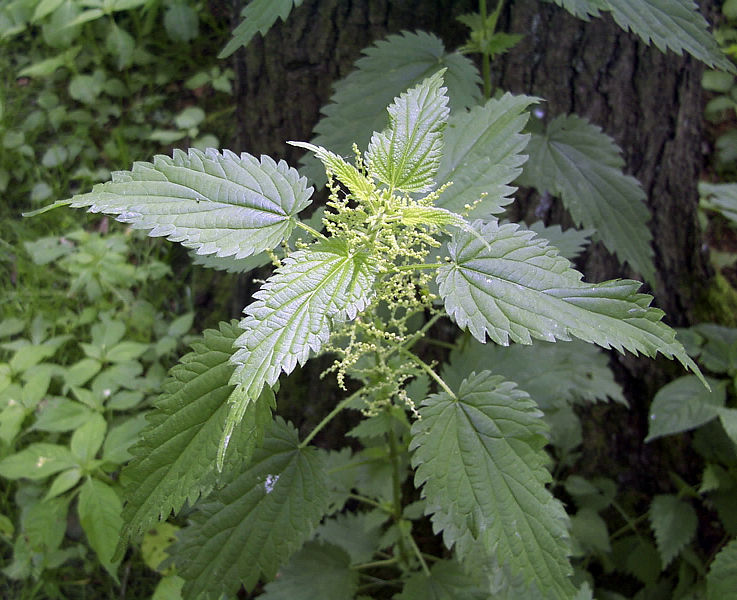
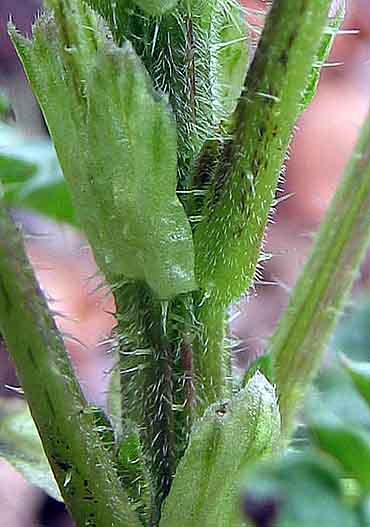
|







 Western and Eastern Poison Oak
Western and Eastern Poison Oak
 Central, Southern, Eastern, and Rydberg's Posion Ivy
Central, Southern, Eastern, and Rydberg's Posion Ivy Touching or rubbing against bruised or broken Poison Oak leaves, or even against the dormant stems in winter, releases an oily resin called "toxicodendrol", which contains the poisonous chemical "urushiol". If you get this oil on your skin, an allergic reaction may result. The severity of this reaction depends on the person, and some people are virtually immune to Poison Oak. However for most, a red, itchy rash appears 30 minutes to 2 weeks after exposure, and lasts for 1 to 2 weeks. This rash is often puffy with watery blisters, and the more you scratch it, the more it spreads. Severe cases can lead to scabs and bacterial infections. The primary first aid is to keep the rash from spreading and getting worse!
Touching or rubbing against bruised or broken Poison Oak leaves, or even against the dormant stems in winter, releases an oily resin called "toxicodendrol", which contains the poisonous chemical "urushiol". If you get this oil on your skin, an allergic reaction may result. The severity of this reaction depends on the person, and some people are virtually immune to Poison Oak. However for most, a red, itchy rash appears 30 minutes to 2 weeks after exposure, and lasts for 1 to 2 weeks. This rash is often puffy with watery blisters, and the more you scratch it, the more it spreads. Severe cases can lead to scabs and bacterial infections. The primary first aid is to keep the rash from spreading and getting worse!
 The best first aid for Poison Oak is to avoid catching it in the first place!
The best first aid for Poison Oak is to avoid catching it in the first place!